[1]
Johwan ahn, Tomotaka daidou, Satoshi tsuneda. Metabolic behavior of denitrifying phosphate accumulating organisms under nitrate and nitrite electron acceptor conditions. Journal of bioscience and bioengineering. 92(5): 442-446(2001).
DOI: 10.1016/s1389-1723(01)80293-0
Google Scholar
[2]
Hu J.Y., Ong S.L., Ng W.J., Lu F, and Fan X.J. A new method for characterizing denitrifying phosphorus removal bacteria by using three different types of electron acceptors. Water Res, 37: 3463-3471(2003).
DOI: 10.1016/s0043-1354(03)00205-7
Google Scholar
[3]
Kuba T, Smolders G, van LoosdrechtMCM, Heijnen J J. Biological phosphorus removal from wastewater by anaerobic–anoxic sequencing batch reactor. Water Science and Technology, 27(5–6): 241–252(1993).
DOI: 10.2166/wst.1993.0504
Google Scholar
[4]
Yan Zhou, Lily Ganda, Melvin Lim, et al. Free nitrous acid (FNA) inhibition on denitrifying poly-phosphate accumulating organisms (DPAOs). Environmental Biotechnology, 88: 359–369(2010).
DOI: 10.1007/s00253-010-2780-3
Google Scholar
[5]
Johwan Ahn, Tomotaka Daidou, Satoshi Tsuneda, Akira Hirata. Selection and dominance mechanisms of denitrifying phosphate-accumulating organisms in biological phosphate removal process. Biotechnology Letters. 23: 2005–2008 (2005).
DOI: 10.1023/a:1013726812529
Google Scholar
[6]
Plisson S S, Mauret M, et al. Process state evaluation of alternative oxic/anoxic activated sludge using ORP, pH and DO. Wat Sci Tech, 38 (3): 299~306(1998).
DOI: 10.2166/wst.1998.0224
Google Scholar
[7]
Hoi-Ping Shi, Chi-Mei Lee, Wei-Hsien Ma. Influence of electron acceptor, carbon, nitrogen, and phosphoruson polyhydroxyalkanoate (PHA) production by Brachymonassp. P12. World Journal of Microbiol and Biotechnol, 23: 625–632 (2007).
DOI: 10.1007/s11274-006-9271-9
Google Scholar
[8]
APHA-AWWA-WEF, Standard methods for the examination ofwater and wastewater, 19th edition,. American Public Health Association/American Water Works Association/Water Environ-ment Federation, Washington, DC, USA, (1995).
Google Scholar


